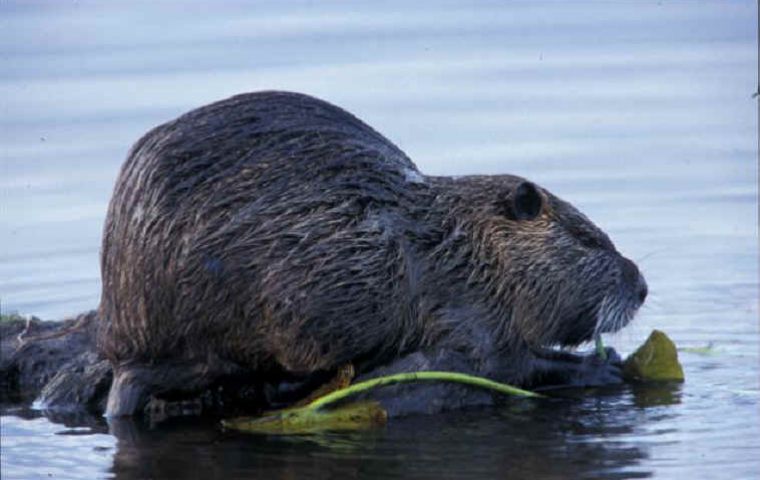MercoPress. South Atlantic News Agency
South America’s nutria, one of the worst invasive species in US wetlands
 The nutria is much appreciated in South America for its fur and meagre meat.
The nutria is much appreciated in South America for its fur and meagre meat. Billions of dollars are spent every year in the United States in an attempt to control invasive species. Plants and animals brought legally and illegally into the US have created extensive damage to the ecosystem and the economy.
Voice of America, VOA, travelled through the Maryland shoreline of the Chesapeake Bay, where nutria - brought from Argentina - has caused irreversible damage. Cindy Saine narrates.
For the last seven years Mario Eusi has been out here in the wetlands of the Chesapeake Bay, (on the East Coast of the United States), trying to control one of the worst invasive species: the nutria.
With his partner Mike Woolsord, they have planted thousands of traps on nutria beds.
During the last decade, about 15,000 nutrias have been eliminated in more than 60,000 hectares of land. But experts say they have many more years to eradicate them. Wildlife biologist Steve Kendrot is in charge of this program for the US Department of Agriculture.
“This is an eradication project” Kendrot explains, “we are not trying to catch these animals alive to move them somewhere else; unfortunately we don't have a place to take them.”
The Blackwater National Wildlife Refuge is where the nutria was originally introduced from South America to the United States in the 1930s when there was a fur farm here.
The nutria is a rodent that can grow to up to 14 kilos. They live mostly in wetlands where they dig holes and eat the vegetation's roots. They can reproduce very fast and have no predators in the area.
Dan Murphy oversees the nutria project at the Fish and Wildlife Service. He says the nutria population expanded to the point where they became a key factor in the destruction of wetlands. He points out the vegetation destroyed by the nutria, and the sensitive wetland soils that have washed away.
“This area behind me was basically hundreds of acres of emergent wetland. Now because of the impact of nutria, the wetland disappeared and what we have now is open water,” he said.
Murphy says rising seawater levels, climate change and nutria are responsible for the destruction of more than 20,000 hectares of wetland in this region.
Wetlands are rich ecosystems for fisheries and birds, like this red-winged blackbird chick.
Large extensions of this shoreline used to be a wooded area. These trees are barely holding on; as the wetlands disappeared, their roots are exposed to salt water. Wetlands protect the coastal line from storms and erosion; its destruction triggers a domino effect of damage.
From this region on the Chesapeake Bay, the nutria expanded to 16 states, according to Leopoldo Miranda, in charge of the Chesapeake Bay Field Office of the US Fish & Wildlife Service.
“The damages are over $200 million,” he says, “and right now we are spending about 1.5 million USD a year to eradicate nutria.”
But the nutria case is not unique. Nearly 50,000 invasive plants and animals are found now through the US. A recent study estimates losses add up to almost 120 billion USD per year. They come from all over the world either legally imported as exotic pets or plants, or as “hitchhikers” on the stream of global commerce.
During a recent congressional hearing in the US, Florida (D) Senator Bill Nelson made a passionate case about the Burmese python brought legally to the US as an exotic pet and released into the wild by their owners.
“This snake has proliferated to the tune of 150,000 in the Florida Everglades National Park,” Nelson said.
In the last 10 years the Burmese python, which can grow over five meters long, have attacked a number of humans, killing seven of them. Senator Nelson called for change in legislation to control these and many other invasive species that do not encounter any predators here.
“This snake coming out of Burma all it knows is it likes moist, humid climates. This is not restricted just to the south end of the Peninsula of Florida,” Nelson adds, “This snakes if it continues to proliferate you will find it all over the southern United States.”
Experts at the US congressional hearing agreed that some invasive species have already crossed the threshold of eradication.




Top Comments
Disclaimer & comment rules-

-

Read all commentsCOSTING $120 BILLION per YEAR!!!???? That is a LOT OF MONEY each and every year. If true, these “invasive” plants and animals need some more attention. How can we ignore this? What can we do? Write congressmen! Request action!
Aug 02nd, 2009 - 12:24 pm 0200 million, Obama has that in spare change.
Aug 02nd, 2009 - 10:15 pm 0Commenting for this story is now closed.
If you have a Facebook account, become a fan and comment on our Facebook Page!